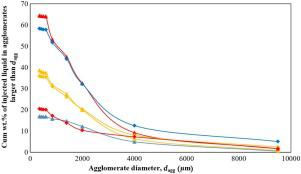Particuology ( IF 4.1 ) Pub Date : 2020-11-23 , DOI: 10.1016/j.partic.2020.10.010 Cedric Briens , Liliana Pardo Reyes , Franco Berruti , Jennifer McMillan

|
In processes such as Fluid Coking™, agglomerate formation should be minimized since it reduces the yield of valuable products, and degrades operability because of the fouling of internals. An experimental model, consisting of an aqueous solution of gum arabic with a dye, has been successfully developed to simulate the formation of agglomerates in the Fluid Coking™ process, where bitumen is sprayed into a fluidized bed of coke particles The particles wetted by a spray could be predicted by assuming that all the particles in the wake of bubbles formed from the tip of the spray jet have been wetted by the injected liquid. The transfer of liquid from particles wetted with the spray to dry bed particles was relatively ineffective, as the number of wet particles increased by only 50%. With successive liquid injections, the proportion of the liquid trapped in agglomerates increases in latter injections: large agglomerates from earlier injections accumulate above the grid and are carried by gas bubbles into the spray jet cavity, where they seed fresh agglomerates.
中文翻译:

连续喷雾对流化床液体分布的影响
在诸如Fluid Coking™之类的工艺中,应最大程度地减少附聚物的形成,因为它会降低有价值的产品的产量,并且由于内部部件的结垢而降低可操作性。已经成功开发了由阿拉伯树胶水溶液和染料组成的实验模型,以模拟在Fluid Coking™工艺中形成附聚物的过程,其中将沥青喷涂到焦炭颗粒的流化床中。可以通过假设喷射喷嘴尖端形成的气泡之后的所有颗粒已被注入的液体润湿来进行预测。液体从被喷雾湿润的颗粒到干燥床颗粒的转移相对无效,因为湿颗粒的数量仅增加了50%。连续注入液体后,









































 京公网安备 11010802027423号
京公网安备 11010802027423号